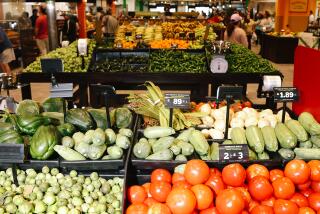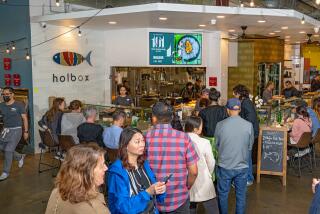Bargains by the pound in London
London
Petticoat Lane is still the best place for a hot egg and bacon sandwich at 7 a.m., sold from a rusting roadside van seemingly held together by layers of old cooking fat. Camden’s warren of markets remains the best spot for browsing a kaleidoscope of trendy arts and crafts, and Portobello Road still operates like a giant open-air bric-a-brac museum.
It’s been 15 years since I was a London street trader, hawking cheap Indonesian handicrafts on a table covered with a bright red batik sheet. But a recent visit to several of the capital’s greatest outdoor and covered markets brought back vivid memories of some of my favorite haunts.
Late last May, on a cloudless blue-sky weekend that could have been in the height of summer, I visited some of the markets I had once worked, along with a few others that I had never seen. I wanted to see how things had changed since my street-vending days and also find out each market’s specialty, where the best shopping was and, of course, what was available to eat besides the early-morning greasy sandwich.
London has 62 diverse street markets, and many, like the gentrified huddle of arts and antiques stalls along Covent Garden’s cobbled walkways, have been around for centuries. None of these markets rests on its laurels. With their ever-changing roster of vendors, they’re always adapting to the times and needs of their patrons.
Petticoat Lane
Perhaps the most famous and — judging by the crush of locals and out-of-towners when I visited on a Sunday — certainly among the most popular is Petticoat Lane Market in the city’s rough and ready East London area. It’s touted as the largest market in Europe, although this may be a stretch of the truth worthy of some of the hawkers who tout their “designer” goods here.Petticoat Lane, which snakes through unremarkable back streets lined with cheap tailor, milliner and luggage shops, is predominantly a market for inexpensive clothing and housewares.
When I visited, dollar-store pots and pans jostled for space with “Calvin Sport” underwear at many stalls, and there was a whiff of black market illegality that prompted several traders to look nervous when I pulled out my notepad.
But spotting the most ludicrous fake and wannabe designer goods is a fun way to pass time. Where else can you buy a $9 “Polo Lauren” golf shirt or pick up the latest watches, accessories and sweaters from such nonexistent design houses as Senate, Swiss Skier and Roberto Bertalicci?
Longtime stall holders at Petticoat Lane also add to the entertainment. A few families have been trading at this market for years; their prime pitches — as the space for the stalls and tables is called — and slick sales patois have been handed down through generations.
When I worked here, I was awed by several stooped, elderly stall holders who kept up running commentaries on their products, engaging passersby with their brazen banter and incredible offers.
These old-school market traders — and there are still some working today — were as entertaining as music hall comedians, and I escaped my stall as often as I could to watch them, all the while making sure I kept enough distance to avoid being roped into making a purchase.
There was a dedicated street for temporary pitchers, or sellers, like me when I worked on Petticoat Lane in the late 1980s.
A collection of irregular traders turned up at 7 a.m. Sundays, hoping the surly market superintendent would hand them a stall.
There was usually enough space for everyone — the market seemed to spread at will throughout the surrounding streets — and even if the regular traders kept their distance from the “temps,” the customers were always pleased to see a new stall.
Camden Lock
It was much harder to win a space at Camden Lock Market in northwest London. Camden contains several markets along its busy High Street, some tumbling into each other so that the lines between them are blurred. Camden Lock Market, where hundreds of indoor and outdoor pitches mingle in a combination of bustling hippie utopia and craven commercial success, is the main market.When I worked here, temporary traders had to arrive at 8 a.m. on Saturdays or Sundays and enter their names in a hat. Those drawn could rent pitches for the day.
Today’s Camden Lock Market has a more artsy and eclectic collection of goods. Hand-decorated glass vases compete for attention with bizarrely painted vintage leather briefcases, while flower petal pendants and carved picture frames populate many stalls. For the kitsch-minded, Jesus action figures and Che Guevara T-shirts and coffee mugs are also for sale.
Although the goods at this market are great for browsing, the food is a definite buy. Of all London’s markets, Camden Lock has the best and most international selection. Its two outdoor food courts, with dozens of stalls, feature huge pots of spicy Indian, Thai and Chinese cuisine.
A filling meal costs less than $9, and everything is cooked before your eyes. The biggest problem is choosing from the dozens of tempting dishes.
Camden Lock was the site of my finest hour as a market trader. Arriving one sunny July morning, my helper and I quickly won a temporary pitch on the edge of the canal. With no awning, we began setting up our trestle table with goods: life-size carved wood ducks, gaudy banana tree 3-D jigsaws, neon parrot-shaped earrings and colorful batik surf shorts.
Before we could get most of our products onto the table, customers began rifling through our opened boxes. It was at least an hour before we managed to set everything up, juggling goods and stuffing 10-pound notes into our pockets every few seconds. The payout that day was enormous and suitably topped off by the tan I picked up during the few hours of selling.
In those days, Camden’s other markets were poor relations to Camden Lock, but now they are serious rivals. One specializes in trendy fashions, albeit of variable quality, and is the place for counterculture T-shirts depicting Muppets in compromising positions and cherry-red, 20-hole Dr. Martens boots with hand-painted toecap patterns.
Camden Canal Market, a subterranean collection of covered stalls, is especially worth a visit for tourists: It has one of the cheapest souvenir stands in London.
You can execute all your gift-buying obligations in less than an hour and still have time to sit down for a restorative chai at the canal-side food court.
Old Spitalfields
The best market for spending time on rainy days is Old Spitalfields, near Liverpool Street Station in a part of the city that’s being rapidly gentrified. A bloody meat market for decades, it was recently transformed into a glorious glass-roofed general market with a Victorian feel. Old Spitalfields has many craft stalls like those in Camden market, but it’s also gaining a reputation as a showcase for cutting-edge and up-and-coming designers. This is where unique wood furniture, painted paper lampshades and trendy one-of-a-kind handbags are sold directly to the public. Underlining the market’s hip credentials is a gourmet organic food section, where truffles, rustic beer and champagne sourdough breads are sold.Old Spitalfields and many of the capital’s main markets are so trendy that it’s easy to forget they are a direct link to the city’s past. London’s first trading was done in the streets long before shops were built, and many of the current markets stand on streets that have been shopping areas for centuries.
Some London streets are named after the products once sold along them — Bread Street, Milk Street and Old Fish Street, which presumably didn’t sell old fish but had a long history of fishmongering. Charles Dickens wrote about London’s markets, using Smithfield, a former Victorian meat market, as a colorful, seedy backdrop in “Oliver Twist” and “Great Expectations.”
Portobello Road
Some of London’s markets, though, thrive on a different link to the past. There has been a Saturday antiques market on Portobello Road since the 1870s. Portobello Road Market opens at 4 a.m. Saturday, when dealers arrive to pick over the trash and treasures at more than 2,000 small wooden tables that line the streets and spill onto the surrounding lanes of Notting Hill, a neighborhood of Georgian townhouses.Battered copper cigarette lighters, politically incorrect ivory curios and military badges and buttons — the kind of items that Grandpa once owned — are emptied onto black-sheeted tables. Every stall seems to have a small glass-topped cabinet crammed with antique and not-so-antique watches. It’s like an exhibition of artifacts that didn’t quite make it into a museum.
Notting Hill’s streets are also lined with a great selection of independent bookshops, vintage clothing boutiques and cozy, wood-floor coffee shops. They make a civilized approach to Portobello Road market, an effect that was mirrored at the final market I visited.
Greenwich Market
A short walk from Greenwich High Street, which teems with interesting shops, is the covered Victorian market, a more laid-back version of Camden Lock. It is an ideal spot to take the family: The community just southeast of central London is filled with young professional families, and the market meets their demands for trendy painted wooden toys, framed art photographs and organic coffees.As I sat with my takeout latte in a corner of the bustling Greenwich market hall, I watched some traders working their pitches.
The key to being a successful London market trader, I decided, is being adept at conversing with strangers. Raising a smile from passing pedestrians always worked when I was a stall holder, although my particular stunt of wearing a pair of surf shorts on my head was just as likely to raise eyebrows.
*
(BEGIN TEXT OF INFOBOX)
*
Goods to go in London
THE MARKETS:
Petticoat Lane Market, https://www.eastlondonmarkets.com . The market, centered on more than a dozen East London streets, including Middlesex, Goulston and Cobb streets and Bell Lane, specializes in cheap clothes and household goods. Most shop 9 a.m.-2 p.m. Sunday. Tube stop: Liverpool Street.
Camden markets, https://www.camdenlock.net/markets.html . Made up of several sites, including Camden Lock Market and Camden Canal Market. Camden’s eclectic street markets specialize in clothes, antiques, jewelry, and arts and crafts. Some indoor stalls are open all week, but the best times to visit are 8 a.m.-6 p.m. Saturdays and Sundays, when indoor and outdoor stalls operate. Tube stops: Camden Town and Chalk Farm. (Follow signs to the market.)
Old Spitalfields Market, https://www.oldspitalfieldsmarket.com/home.htm . This smaller market specializes in jewelry, interior design and original clothing. Open 10 a.m.-4 p.m. Monday-Friday, but 9 a.m.-5 p.m. Sunday is the best time to visit because all the market’s 200 stalls are open. Tube stops: Aldgate, Aldgate East and Liverpool Street.
Portobello Road Market, https://www.portobelloroad.co.uk . A sprawling antiques and flea market with stalls that run from Chepstow Villas to under the Westway motorway. Open 4 a.m.-6 p.m. Saturdays. Tube stops: Notting Hill Gate and Ladbroke Grove. (Follow the signs and crowds to the market.)
Greenwich Market, https://www.greenwich-market.co.uk . A less frenetic market that caters to local professional families with a trendy selection of crafts and gentrified antiques. Open 9 a.m.-5 p.m. Saturdays and Sundays. A short walk from the Cutty Sark or Greenwich Docklands Light Railway stations.
TO LEARN MORE:
Visit Britain, 551 Fifth Ave., Suite 701, New York, NY 10176; (800) GO-2-BRITAIN (462-2748), https://www.visitbritain.org .
— John Lee
More to Read
Sign up for The Wild
We’ll help you find the best places to hike, bike and run, as well as the perfect silent spots for meditation and yoga.
You may occasionally receive promotional content from the Los Angeles Times.






